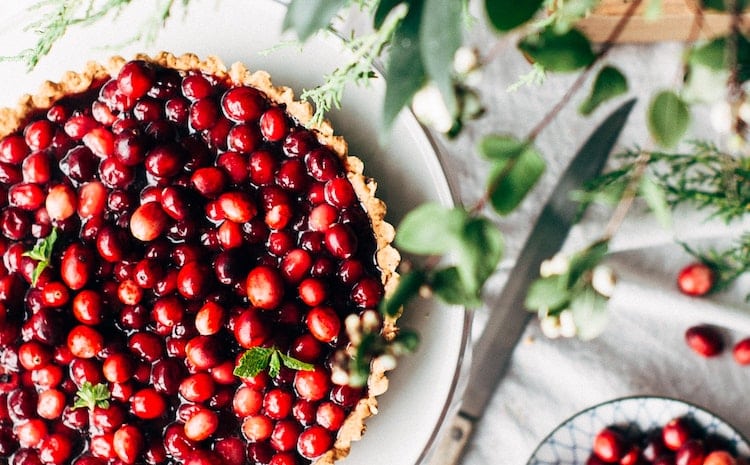As the holidays approach and the temperature begins to drop in the Northern Hemisphere, many of us find ourselves reaching for sweets, treats, and comfort foods. The end of the calendar year certainly puts to the test any healthy habits we have cultivated during the year.
If we are open to embracing this as an opportunity for increased presence and reflection, we might feel called to explore mindful eating during the holidays. Having little to do with rules and regulations, mindful eating is fundamentally about paying attention. When practiced, it can bring an added richness to whatever it is we might indulge in this season.
This comprehensive guide to mindful eating during the holidays includes:

What is Mindful Eating?
As noted, mindfulness is about paying attention to whatever is happening, moment to moment. Jan Chozen Bays, Zen master and author of Mindful Eating: A Guide to Rediscovering a Healthy and Joyful Relationship with Food, applies this principle to the act of eating in saying:

“Mindful eating is deliberately paying full attention to what you are eating or drinking, without criticism or judgment.”
- Jan Chozen Bays -
Just as we would pay attention to any other aspect of our experience in mindfulness practice, mindful eating invites us to cultivate non-judgmental awareness of the process of eating. Some of the things we might become aware of while eating include:
We can expand this practice to include awareness of the room we are eating in and all those in it. We might also practice cultivating awareness while cooking, noting similar elements of our experience as listed above. Furthermore, mindfulness of the food itself might include an awareness of the soil the ingredients came from, the hands that nurtured these ingredients, and the systems that delivered them to us.
Take our free mindfulness of eating course.
Why Eat Mindfully During the Holidays?
At any time of the year, the benefits of mindful eating are widespread. During the holidays (or any other occasion when we might overconsume or consume mindlessly), mindful eating is all the more important.
Some of the benefits of mindful eating include:
In addition to these impressive health benefits, mindful eating can also increase our sense of pleasure and satisfaction. When we eat mindlessly, it is usually because we are distracted. We might be watching TV, worrying about the day behind us, or scrolling through our phone. Before we know it, we have finished eating a meal that we were barely present for.
On the contrary, mindful eating invites the fullness of our attention to the experience of eating. It encourages us to take note of the process from start to finish. As Jan Chozen Bays writes:

“If we want to feel satisfied as we eat, the mind has to be aware of what is occurring in the mouth. In other words, if you want to have a party in the mouth, the mind has to be invited.”
- Jan Chozen Bays -

9 Mindful Eating Tips for the Holidays
Mindful eating isn’t about making a list of rules. It is not about judging ourselves for what we consume, nor is it about following a certain ‘healthy’ diet. Instead, consider these simple tips for mindful eating this holiday season:
1. Savor the flavors.
Regardless of what you are eating, you can bring mindfulness to the process by really paying attention to the flavors. Let the attentive mind join in on the festivities as you note the sweet, salty, spicy, bitter, sour, and pungent notes in the foods you consume. Be fully present to the wonder of your tastebuds.
2. Play with all your senses.
Beyond savoring the flavors, you can tune into the food you eat with the other senses. What does the food look like? What does it smell like? What does it feel like? What sounds does it make as you chew? Noticing the full spectrum of your senses brings a richness to your eating habits.
3. Eat slowly.
When in doubt, slow it down. Many of us eat quickly, but when we slow down the process, we are able to enjoy each meal to a larger degree. Take your time to really savor this wonderful meal that has found its way to your plate.
4. Practice gratitude.
Cultivate thankfulness by offering gratitude for your food. This can be a practice that you share with loved ones before a meal or you can explore it on your own. Note all that there is to be thankful for on your plate: the food itself, the seeds, the soil, and the hands that helped along the way from farm to fork.
5. Practice self-compassion.
Over the holidays, many of us indulge a little more than we normally do. This can stir thoughts of guilt and self-judgment. Mindfully notice where you might be judging yourself and see if you can tend to yourself with loving-kindness instead. Consider mindfulness exercises for self-compassion to assist you.
6. Be mindful of your needs.
Having self-compassion is not an invitation to indulge carelessly and mindlessly. It is equally important to be mindful of our needs. What foods don’t sit well with us? How do different holiday beverages impact our sense of wellbeing? Be mindful of what nourishes you, using this awareness to guide your actions.
7. Be mindful of your mood.
The mood we are in has an impact on the foods we choose to eat. When we are in a positive mood, we are more likely to make healthier choices. Since the holidays can stir a range of feelings such as anxiety and frustration, mindfulness of our emotions can help us to address these moods most optimally.
8. Notice your hunger and fullness cues.
How often do you tune into what it feels like to be hungry or to be full? Often, we let our mind dictate our eating habits rather than listening to our bodies. So, it can be helpful to consider: What does it feel like to be hungry? What sensations tell me when I have had enough? When it comes to feelings of fullness, eating slowly can support our ability to notice these cues.
9. Observe your body – and don’t forget to breathe.
During the holidays, we might find our digestion in need of a little bit of support. One of the best ways we can support this bodily system is to notice where we are stressed or contracted and to see if we can soften that tension. Coming back to the breath through mindful breathing can support this. Soften your shoulders, relax your belly, and enjoy the blessing of the meal before you.
For more mindful tips for the holidays, check out our complete guide to holiday gift-giving.
A Simple Mindful Eating Practice
As the holidays approach, you might take an opportunity to harness your mindful eating skills by practicing this simple mindful eating exercise. To practice, choose a small food item, such as a cracker, a berry, or a piece of chocolate. Alternatively, you could practice this with a warm beverage like tea or warm apple cider.
Find a comfortable place to sit, turn off or tuck away any distractions, and then begin:

4 Additional Mindful Eating Exercises
For more guidance on how to eat mindfully, check out the following four mindful eating exercises:
References:
- 1Bays, Jan Chozen. Mindful Eating: A Guide to Rediscovering a Healthy and Joyful Relationship with Food. Shambhala Publications, 2009.
- 2Cherpak, Christine E. Mindful Eating: A Review Of How The Stress-Digestion-Mindfulness Triad May Modulate And Improve Gastrointestinal And Digestive Function. Integrative Medicine (Encinitas), Aug. 2019, www.ncbi.nlm.nih.gov/pmc/articles/PMC7219460/.
- 3Gardner, Meryl P., et al. Better Moods for Better Eating?: How Mood Influences Food Choice. Journal of Consumer Psychology, July 2014, www.sciencedirect.com/science/article/abs/pii/S1057740814000060.
- 4Jordan, Christian H., et al. “Mindful Eating: Trait and State Mindfulness Predict Healthier Eating Behavior.” Personality and Individual Differences, 10 May 2014, www.sciencedirect.com/science/article/abs/pii/S0191886914002396.
- 5Miller, Carla K, et al. Comparison of a Mindful Eating Intervention to a Diabetes Self-Management Intervention among Adults with Type 2 Diabetes: a Randomized Controlled Trial. U.S. National Library of Medicine, Apr. 2014, www.ncbi.nlm.nih.gov/pmc/articles/PMC4217158/.
- 6O'Neal, Dave. Talking with Jan Chozen Bays About Mindful Eating. Shambhala Publications, www.shambhala.com/talking-with-jan-chozen-bays-about-mindful-eating/.








